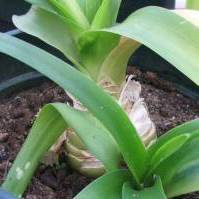
5 Albuca batteniana Seeds - Indigenous South African Bulbous Plant Seeds - New
Check my rate
| Main centres: | 1-3 business days |
| Regional areas: | 3-4 business days |
| Remote areas: | 3-5 business days |

| Main centres: | 1-3 business days |
| Regional areas: | 3-4 business days |
| Remote areas: | 3-5 business days |
Albuca is a genus of about 60 to 70 species belonging to the hyacinthaceae family. Albuca batteniana is not a commonly known garden plant, but a collector's jewel and specialist species. Albucas, as can be seen from the photograph, deserve more horticultural merit than they are usually accorded. Description This is an evergreen bulb, with firm, truncate and fibrous scales, that grows above the ground with only the roots embedded in the soil. It grows up to 0.6 m in height. The leaves are firm and lanceolate. The flowers are erect, on long pedicels, white with pale greenish keels, 25-40 mm long, with the outer tepals spreading-curved, the inner tepals cowled above, and the outer anthers are larger is than the inner. It flowers from July–October. All Albuca species grow from bulbs, and most have a dormancy period after flowering whereby they lose their leaves. The flower scape is, like almost all Hyacinthaceae, unbranched. Most species only produce one scape per growing season, although some, such as Albuca flaccida and Albuca maxima, may produce two or more; the tropical African species may produce scape after scape after scape in optimal conditions. The majority of species are winter-growers, mainly originating from the south-west Cape and northwards into Namaqualand, South Africa. The genus also extends into tropical Africa and Arabia, where there are comparatively fewer species. The most characteristic feature of the genus is the shape of the flower. The outer 3 tepals spread out like any normal flower, but the inner 3 stay more or less closed. The general appearance is therefore somewhat like a snowdrop Galanthus. The flowers do come in a limited color range, white and yellow through to green, but are usually embellished with a green stripe down the middle of each outer tepal. Some species also have the tips of the inner, closed tepals colored differently, either with white or bright yellow. Flowers are either presented in a nodding or drooping formation, or erect on firm pedicels (flower stalks). The tropical African species, on the other hand, have flowers on such short pedicels that the only position they can hold is sideways. On offer is a pack of 5 Seeds We'll supply you with all the germination & care instructions. |